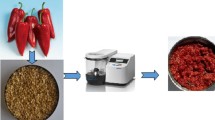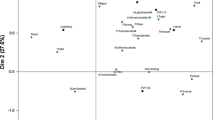Abstract
The current work aimed to formulate smoothie by optimizing varying levels of soy protein isolate (1.5–2.5% w/w), sucralose (150–190 ppm) and pectin (0.3–0.5% w/w) along with milk, legume (chickpea), vegetable (carrot), fruit (mango), honey and trisodium citrate by response surface methodology on the basis of sensory (color and appearance, flavor, consistency, sweetness and overall acceptability) and physical (expressible serum and viscosity) responses. Soy protein isolate and pectin levels influenced color and appearance, flavor, consistency and overall acceptability significantly. Soy protein isolate and pectin showed a positive correlation with viscosity of smoothie with reduced expressible serum. Smoothie was optimized with 1.8% (w/w) soy protein isolate, 166.8 ppm sucralose, and 0.5% (w/w) pectin with acceptable quality. One serving (325 ml) of optimized smoothie provides approximately 23% protein, 27% dietary fiber of the recommended daily values and provides approximately 74 kcal per 100 ml of smoothie, which renders smoothie as a high protein, high fiber, grab-and-go breakfast option.


Similar content being viewed by others
References
AOAC (2000) Official methods of analysis, 17th edn. Association of Official Analytical Chemists, Gaithersburg
Ashraf H-RL, Snyder HE (1981) Influence of ethanolic soaking of soybeans on flavor and lipoxygenase activity of soymilk. J Food Sci 46:1201–1204
Chinma CE, Ariahu CC, Abu JO (2013) Chemical composition, functional and pasting properties of cassava starch and soy protein concentrate blends. J Food Sci Technol 50:1179–1185
Deshpande R, Chinnan M, McWatter K (2008) Optimization of a chocolate-flavored, peanut–soy beverage using response surface methodology (RSM) as applied to consumer acceptability data. LWT-Food Sci Technol 41:1485–1492
Doesburg J, de Vos L (1959) Pasteurized mixtures of fruit juices and milk, with a long shelf life, Int Fruit Juice Congr 2nd Report 32, pp 32–37
Glahn P (1982) Hydrocolloid stabilization of protein suspensions at low pH. Prog Food Nutr Sci 6:171–177
Granato D, Ribeiro JCB, Castro IA, Masson ML (2010) Sensory evaluation and physicochemical optimisation of soy-based desserts using response surface methodology. Food Chem 121:899–906
Hanger L, Lotz A, Lepeniotis S (1996) Descriptive profiles of selected high intensity sweeteners (HIS), HIS blends, and sucrose. J Food Sci 61:456–459
Henika R (1982) Use of response-surface methodology in sensory evaluation. Food Technol 36:96–101
Hettiarachchy N, Kalapathy U (1998) Functional properties of soy proteins. ACS Publications, Washington
Indian Council of Medical Research (ICMR) (2010) Nutrient requirements and recommended dietary allowances for Indians. http://icmr.nic.in/final/rda-2010.pdf. Accessed 24 July 2016
Khurana HK (2006) Development of technology for extended shelf life fruit lassi. Ph.D. Thesis. N.D.R.I.-Karnal, Karnal, Haryana, India
Kinney AJ (2003) Engineering soybeans for food and health. AgBioForum 6:1–5
Klein BP, Perry AK, Adair N (1995) Incorporating soy proteins into baked products for use in clinical studies. J Nutr 125:666S–674S
Knight I (1994) The development and applications of sucralose, a new high-intensity sweetener. Can J Physiol Pharmacol 72:435–439
Kumar P, Mishra HN (2004) Mango soy fortified set yoghurt: effect of stabilizer addition on physicochemical, sensory and textural properties. Food Chem 87:501–507
Lam M, Paulsen P, Corredig M (2008) Interactions of soy protein fractions with high-methoxyl pectin. J Agric Food Chem 56:4726–4735
Lucey J, Tamehana M, Singh H, Munro P (1999) Stability of model acid milk beverage: effect of pectin concentration, storage temperature and milk heat treatment. J Texture Stud 30:305–318
Maroziene A, De Kruif CG (2000) Interaction of pectin and casein micelles. Food Hydrocoll 14:391–394
Montgomery DC, Myers RH (1995) Response surface methodology: process and product optimization using designed experiments. Wiley, New Jersey
National Institute of Nutrition (2011) Dietary Guidelines for Indians. http://ninindia.org/dietaryguidelinesforninwebsite.pdf. Accessed 23 July 2017
Neumark-Sztainer D, Eisenberg ME, Fulkerson JA, Story M, Larson NI (2008) Family meals and disordered eating in adolescents: longitudinal findings from project EAT. Arch Pediatr Adolesc Med 162:17–22
Parker A, Boulenguer P, Kravtchenko TP (1994) Effect of the addition of high methoxy pectin on the rheology and colloidal stability of acid milk drinks. In: Nishinari K, Doi E (eds) Food hydrocolloids. Springer, New York, pp 307–312
Rackis JJ, Sessa DJ, Honig DH (1979) Flavor problems of vegetable food proteins. J Am Oil Chem Soc 56:262–271. doi:10.1007/bf02671470
Rani R, Kumar MHS, Sabikhi L (2016) Process optimisation for a ready-to-serve breakfast smoothie from a composite milk–sorghum base. Int J Dairy Technol 69:372–379
Saxena D, Chakraborty SK, Sabikhi L, Singh D (2015) Process optimization for a nutritious low-calorie high-fiber whey-based ready-to-serve watermelon beverage. J Food Sci Technol 52:960–967
Shukla F, Jain S, Sandhu K (1986) Effect of stabilizers and additives on the diacetyl and volatile fatty acids contents of yoghurt. Ind J Dairy Sci 39:486–488
Singh AK, Singh K (2012) Utilization of whey for the production of instant energy beverage by using response surface methodology. Adv J Food Sci Technol 4:104–111
Singleton N, Rhoads DS (1982) Meal and snacking patterns of students. J School Health 52:529–534
Smith KJ, Gall SL, McNaughton SA, Blizzard L, Dwyer T, Venn AJ (2010) Skipping breakfast: longitudinal associations with cardiometabolic risk factors in the Childhood Determinants of Adult Health Study. Am J Clin Nutr 92:1316–1325
Stone H, Sidel J, Oliver S, Woolsey A, Singleton RC (2008) Sensory evaluation by quantitative descriptive analysis. In: Gacula MC (ed) Desriptive sensory analysis in practice. Food and Nutrition Press Inc., Connecticut, pp 23–34
Syrbe A, Bauer W, Klostermeyer H (1998) Polymer science concepts in dairy systems-an overview of milk protein and food hydrocolloid interaction. Int Dairy J 8:179–193
US Food and Drug Administration (2013) Appendix B: additional requirements for nutrient content claims. Guidance for Industry: A Food Labeling Guide. https://www.fda.gov/downloads/Food/GuidanceRegulation/UCM265446.pdf. Accessed 23 July 2017
USDA Food and Nutrition Service (2013) Team Nutrition. https://www.fns.usda.gov/tn/team-nutrition. Accessed 23 July 2017
Acknowledgements
The authors are thankful to National Dairy Research Institute, Karnal for providing funding and research facilities. We are also grateful to M/s. Huber India Pvt. Ltd. Mumbai for their generous supply of pectin sample.
Author information
Authors and Affiliations
Corresponding author
Rights and permissions
About this article
Cite this article
Mehta, D., Kumar, M.H.S. & Sabikhi, L. Development of high protein, high fiber smoothie as a grab-and-go breakfast option using response surface methodology. J Food Sci Technol 54, 3859–3866 (2017). https://doi.org/10.1007/s13197-017-2841-z
Revised:
Accepted:
Published:
Issue Date:
DOI: https://doi.org/10.1007/s13197-017-2841-z




